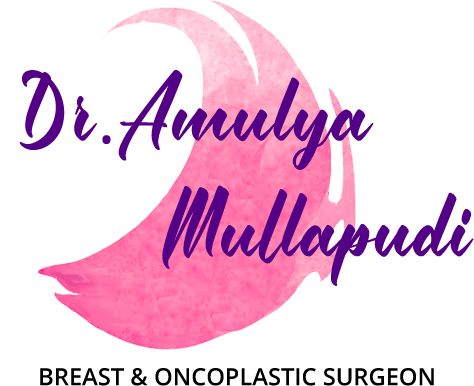Benign Breast Disorder
What are Benign Breast Disorders?
The word Benign literally means mild or unharmful and Disorder means lack of order or irregularity.
A group of conditions in the breast that are commonly not harmful, are called the benign breast disorders. Few of these disorders may be indicators of further changes in the breast, at some point in time, and this may warrant follow-up.
Get the benign breast disorder treatment in Vijayawada from Dr. Amulya Mullapudi. We are offering Benign Breast Disorder treatment from our location to people who are living in and around Guntur, Visakhapatnam, Rajahmundry, Eluru, Gudivada, Tadepalligudem, Tanuku, Bhimavaram, Palakollu and Narsapuram.
Causes of Benign Breast Disorders
These disorders can develop as
- 1) part of the normal breast developmental process or
- 2) part of regression of breast tissue that happens with aging or
- 3) due to increased production of normal cells.
A few factors that play a role in bringing about these changes:
- 1) Changes in breast tissue - due to hormonal fluctuations, particularly during menstruation, pregnancy, and menopause.
- 2) Breast infection
- 3) Scar tissue from a breast injury.
- 4) Taking medications like hormonal contraceptives or hormonal replacement therapy
- 5) Lifestyle - smoking, unhealthy diet, over weight
Who can present with these disorders ?
- 1) Young girls after the breast development starts;
- 2) Young women in the reproductive age group;
- 3) Women nearing menopause or attained menopause.
- 4) Gynaecomastia may be seen in men.
Important: It is important to understand that though most of the breast symptoms may seem benign, every new symptom, if it persists for longer than 4 - 6 weeks, needs to be checked at breast cancer hospitals in Vijayawada to confirm it is truly not cancer.
What could be the symptoms?
You might see breast changes or a lump while doing a breast self-exam, showering or getting dressed. Sometimes a mammogram detects these changes. Besides a breast lump, other symptoms of benign breast disease could be
- 1) Breast pain
- 2) Heaviness in the breasts.
- 3) Previously known breast lump - growing in size recently
- 4) Nipple discharge
- 5) Inverted nipples - new change
- 6) Scaly nipples
Types of Benign Breast Disorders
- 1) Fibrocystic breast changes: generally appear in women aged between 20 to 50 years. Part of the breast growth process initially and can extend up to menopause when the breast involution takes place. Hyperplasia is overgrowth of the cells that line mammary ducts or glands that is part of the fibrocystic changes.
- 2) Breast Cysts: lumps that are filled with water, make up to 25% of breast lumps. Although, breast cysts can be painful and lumpy in some women, they do not increase your risk of cancer.
- 3) Fibroadenomas: solid, non-cancerous, painless breast lumps can affect most women between the ages of 15 and 35. Usually remain unnoticed in majority of women. May present as multiple lumps in each breast.
- 4) Phyllodes tumour: these breast tumours can range from benign to intermediate to malignant. Similar to fibroadenomas on breast imaging. Grow rapidly. Surgical removal is recommended. They carry a risk of recurrence.
- 5) Lactational infections
- 6) Nipple discharge: can be physiological like after breast feeding or duct dilation. Due to intra-ductal papillomas - small growths formed within the duct.
- 7) Others - fat necrosis: Lumps in the breast occurring commonly after injury to breast, can also appear following surgery, injections into the breast and radiotherapy.
Treatment for Benign Breast disorders
Breast health should be a priority for all of us to prevent any chronic diseases. The first thing would be to consult a doctor with expertise in diagnosis and treatment of breast diseases. Vida Breast Care Centre is a dedicated health care centre to deal with such disorders.
A clinical examination is necessary for initial assessment, then an ultrasound scan or a mammogram is requested for confirmation, following which, the respective treatment plan is proposed and discussed. A needle biopsy for tissue sample from the breast lump may be requested for obtaining solid proof for diagnosis.
Amongst the different types of benign breast disorders, a majority do not increase the risk of cancer and do not require treatment. Surgical removal or follow-up of the offending lump that increases your risk of breast cancer in the future may be advised, as required.
